
Why a “Data Hub?”
Florida's Early Learning Roadmap acknowledges that we need more than increased investment to support Florida children, families and the economy: we need careful coordination among systems and regular data analysis.
With this in mind, we created Florida's Early Learning Data Hub. While we are not data scientists, there are already many good sources of data for early learning, maternal and child health, early intervention, and basic demographics. We simply brought these together in an easy, centralized place. Our aim is to contribute to a data-informed conversation among practitioners and advocates working for the best possible future for Florida children.
How to Use the Data Hub
You’ll find data tiles broken down into six sections:
- Early Childhood Demographics
- Early Learning Programs
- Early Learning Workforce
- Maternal and Child Health
- Healthy Development
- Funding
When you click the number in the data tile, it opens up to reveal a larger data set or visual with a source linked. Many of the sources have more in-depth data—often by county, sometimes with an interactive dashboard—and you can cite the trusted external source for any research.
These data points can be used individually or in combination to tell a story of progress or need in Florida communities. Use this as a reference or a launching point for further investigation.
Early Childhood Demographics
221,413
There are approximately 220,000 babies born every year in Florida.
Source: FL Health CHARTS (interactive dashboard and county level data available)
Babies Born Annually in Florida
42.2%
In Florida, 42.2% of all births in 2023 were covered by Medicaid, equating to 93,160 babies.
Source: FL Health CHARTS
Annual Births Covered by Medicaid in Florida
1,356,788
There are more than 1.3 million early learners in Florida—that is, children aged 0-5.
Source: U.S. Census Bureau
0-5 Population in Florida
896,000
There are more than 890,000 early learners in Florida with all available parents in the workforce, equating to 69% of young children in the state.
Source: KIDS COUNT Data Center
0-5 Population with All Available Parents in the Workforce
70%
70% of Florida children under the age of 6 have all available parents in the workforce, equating to roughly 908,000.
Source: KIDS COUNT Data Center
Percentage of 0-5 Population with All Available Parents in the Workforce
714,768
In 2023, there were 714,768 children (0-18) in Florida living below the federal poverty level, which amounted to $30,000 for a family of four. This is a decrease from the year prior and continues the decade-long trend of childhood poverty decreasing.
Source: U.S. Census Bureau
Children Living in Poverty
47%
In 2023, 13% of Florida households lived below the federal poverty level, unchanged from the year prior. In addition to that, 34% of Florida households qualify as ALICE (Asset Limited, Income Constrained, Employed); ALICE households are those above the poverty threshold that cannot afford the basic cost of living in their county. (Note there is no publicly available data on ALICE in Florida in 2017 or 2020.)
Source: United for ALICE (county-level data and interactive map available on United for ALICE)
Households below the ALICE Threshold
21%
Last school year, more than 40,000 kindergarten-age English Language Learners (ELLs) were tested for English-language proficiency, with 5% of test takers already considered proficient.
Source: Florida Department of Education
Percent of Public School English Language Learners (ELLs)
84,000+
According to the latest data, more than 84,000 young children in Florida are lacking health coverage--a basic necessity that ensures their ability to lead happy, healthy lives.
Sources: Georgetown University and U.S. Census Bureau
Uninsured Children (0-5 Population)
Early Learning Programs
385,686
More than 380,000 early learners are currently served across four publicly funded programs - Voluntary Pre-Kindergarten (VPK), School Readiness (SR), and Head Start/Early Head Start - with 22,190 of those children served by both the VPK and SR programs.
Children in publicly funded early learning programs
11,907
There are more than 11,900 child care centers and family child care homes in Florida, with home-based programs making up about 20% of the total.
Source: Florida Department of Children and Families (May 2025)
Child Care Providers in Florida
1,925
As of June 2025, there are 1,925 providers with the Gold Seal Quality Care Program designation, given to those who meet or exceed quality standards as demonstrated through one of 15 approved accrediting agencies. Nearly 40% achieve the designation through Accredited Professional Preschool Learning Environment (APPLE). To view the full list of accrediting agencies, visit the Florida Department of Education.
Source: Florida Department of Education
Gold Seal Quality Care Providers
9,341
There are 6,790 providers contracted to offer Florida's Voluntary Pre-Kindergarten Education Program and/or the School Readiness programs.
Source: Florida Department of Education
Child Care Providers Contracted for state-funded programs
65%
65%, equating to more than 150,000, of 4-year olds, all of whom are eligible by law, were enrolled in Florida's VPK program in 2024, a slight decrease from 67% served in 2023.
Source: National Institute for Early Education Research (state-level enrollment and funding data available on NIEER's data explorer)
Percentage of Eligible Students Served by VPK
43%
Florida's Kindergarten Readiness rate of 43% in 2025 shows a decline from the prior year as the standards for the "cut score" for readiness were raised by the Department of Education. This is an important measure, and the graph below shows it's hard for children to catch up if they're missing the fundamentals. (Note comparison data for 3rd grade reading is not available for 2020.)
Sources: Florida Department of Education and Florida Scorecard (State-level heat map available at the Florida Scorecard)
Kindergarten Readiness
30
There are 30 Early Learning Coalitions (ELCs) throughout Florida, which manage county-level early learning funds and exist to help parents enroll in School Readiness, VPK, or get information or referrals for early learning programs and services in their area. This map shows which Coalition covers each county in Florida.
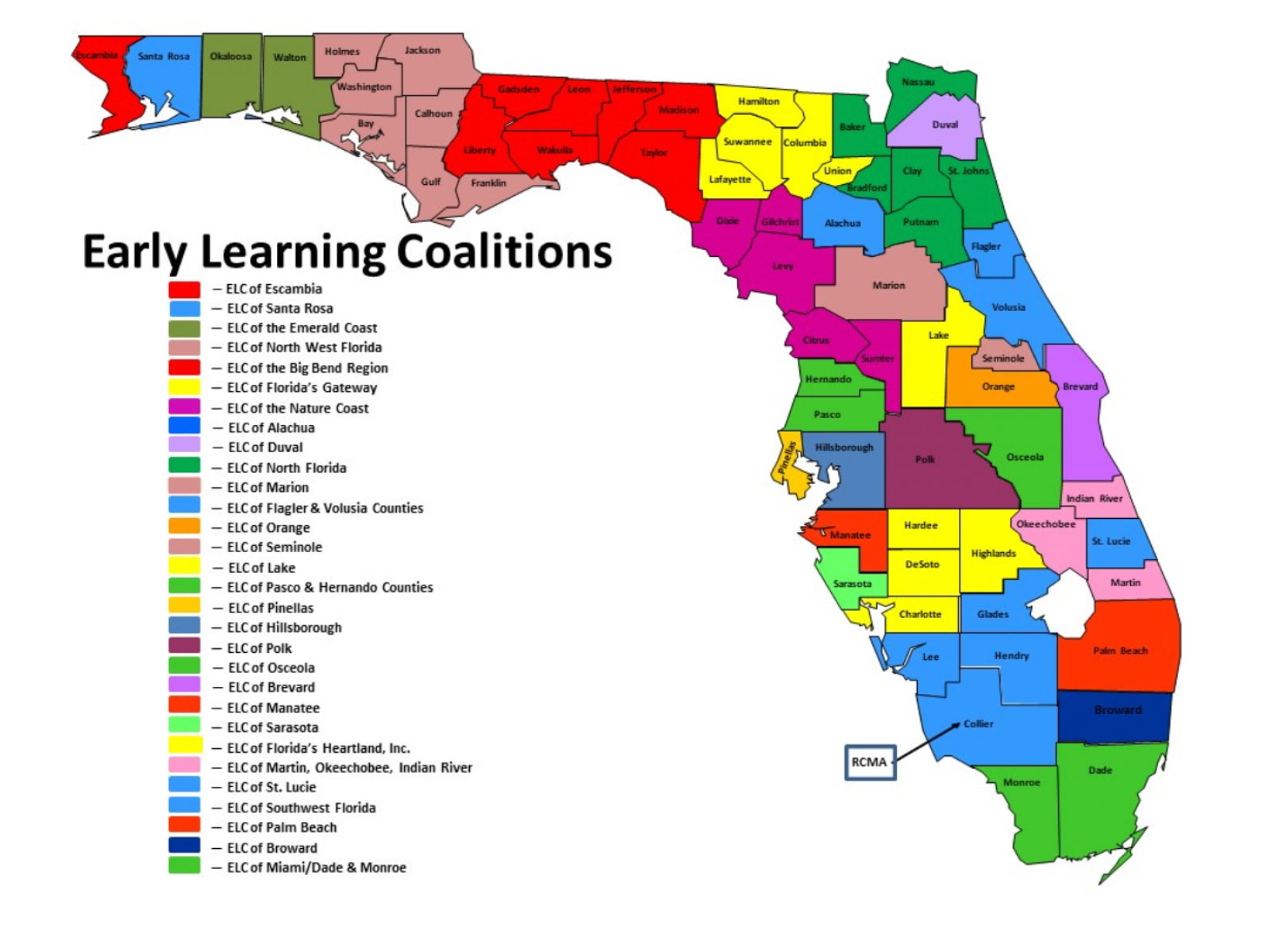
Sources: Association of Early Learning Coalitions and Florida Department of Education (map and more information on ELCs available at first link; directory of ELCs available at second)
Early Learning Coalitions
~15,000
School Readiness waitlist data is not published on a regular basis but is available, by county, via a public records request. In January 2025, the number was just over 14,900 for the entire state.
?
School Readiness Program Waitlist
45,050
In 2024, funded enrollment for the Head Start program in Florida was 45,050. Early Head Start (ages 0-3) had 12,671 slots and Head Start had 32,349.
Source: Florida Head Start Association (county-level data and interactive dashboard available)
Florida Head Start Funded Enrollment
128,960
More than 128,000 children lack access to child care. There are currently 776,050 available slots, while there are 883,090 potential slots needed.
Source: Child Care Gaps Assessment (county-level and senate district-level data is available to view.)
Child Care Gap in Florida
Early Learning Workforce
~70,000
There are tens of thousands of early learning/child care practitioners in Florida, but the exact number of teachers active in the classroom is not available. What we do know is that these teachers are making an important contribution to Florida's economy.
?
Early Learning Teachers
11,143
As of 2023, early learning educators in VPK classrooms must hold the Emergent Literacy Micro-Credential, making them uniquely qualified to teach literacy skills to our youngest learners. A micro-credential is a short, focused certification that verifies specific skills or knowledge, often earned through targeted courses or assessments. Unlike traditional degrees, micro-credentials are typically digital, stackable, and designed to meet specific workforce or personal development needs.
Early Learning Educators with Micro-Credential
4,956
In 2024, there were nearly 5,000 active T.E.A.C.H. scholars working and learning in Florida, an increase of 940 over the prior year. Since 1998, the year the T.E.A.C.H. program began, 47,500 educators and students have utilized these scholarships to pursue a career in early learning.
Source: T.E.A.C.H Florida
T.E.A.C.H. Scholars
10,549
In 2024, 10,549 staff were employed by Florida Head Start programs, over 2,000 of which were or currently are parents of Head Start children.
Source: Florida Head Start Dashboard (interactive data dashboard available)
Staff Employed by Head Start
38
There are 38 institutions of higher education – from state colleges and universities as well as private institutions – that offer credential and/or degree programs for aspiring early learning educators and continuing education. Click on the map to zoom in and learn more about each school's offerings.
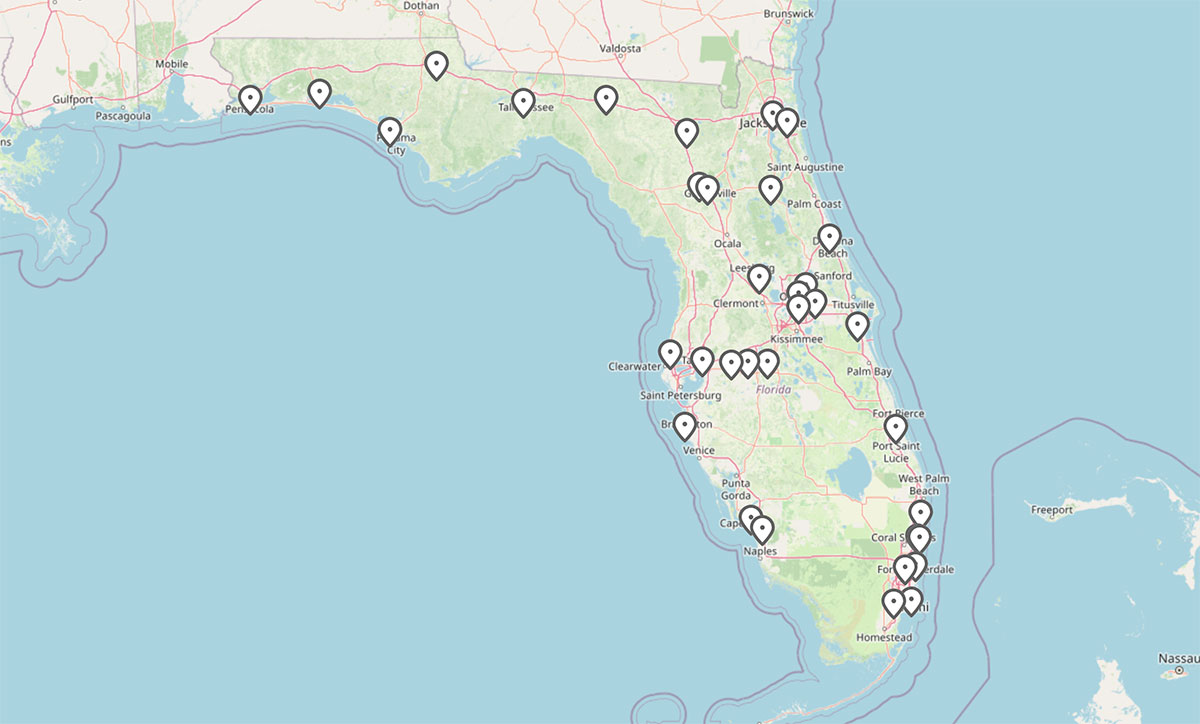
Florida Colleges and Universities with Early Learning Programs
?
There is no reliable data source for the level of education or credentials for early learning teachers currently employed in the field. The DCF directory does have some information, but it is not comprehensive. (For example, we know that more than 4,000 teachers hold a credential.)
?
Source: Florida Early Childhood Professional Development Registry
Early Learning Teacher Qualifications
6 of 67
Only 6 of Florida's 67 counties participate in some kind of salary supplement program for early education practitioners as of mid-2025, including the statewide INCENTIVE$ program.
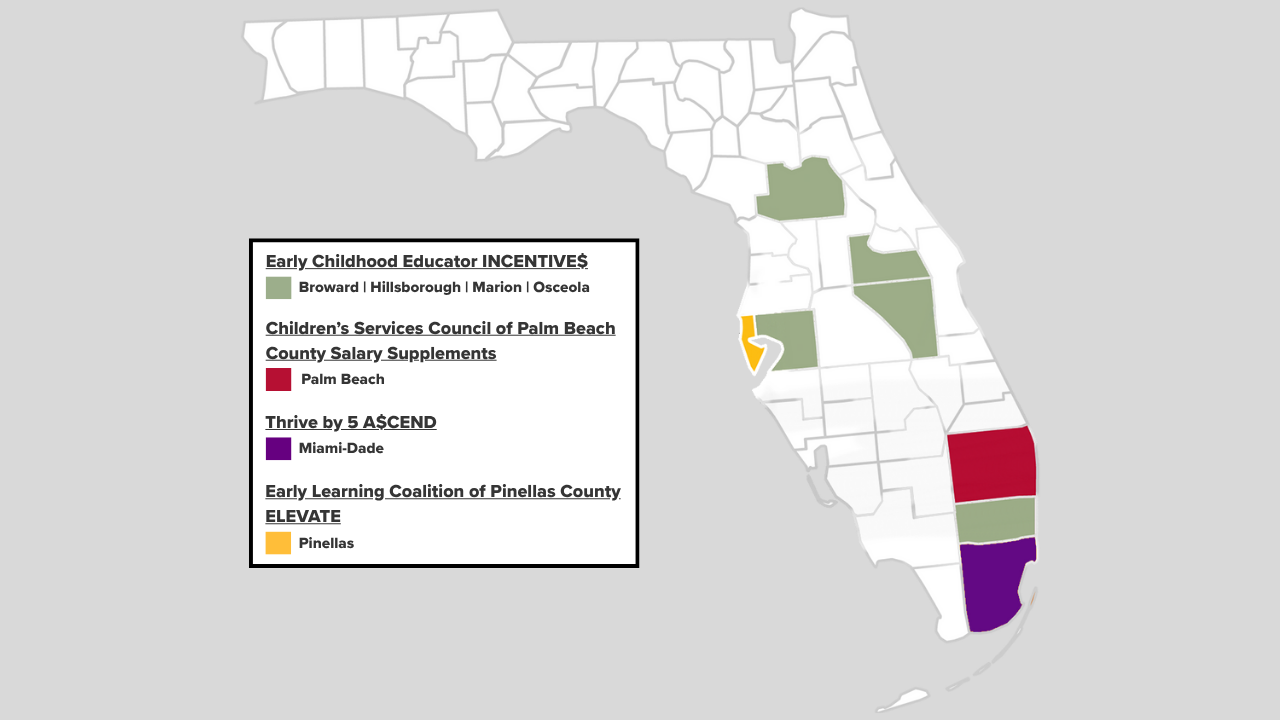
Sources: INCENTIVE$ and Early Learning Coalition of Pinellas County and Children’s Services Council of Palm Beach County and The Children's Trust (June 2025)
Wage Incentive Programs
Healthy Birth Outcomes
10.70%
10.7% of Florida babies were born pre-term in 2023, with the rate among black women 1.5 higher than that of other babies.
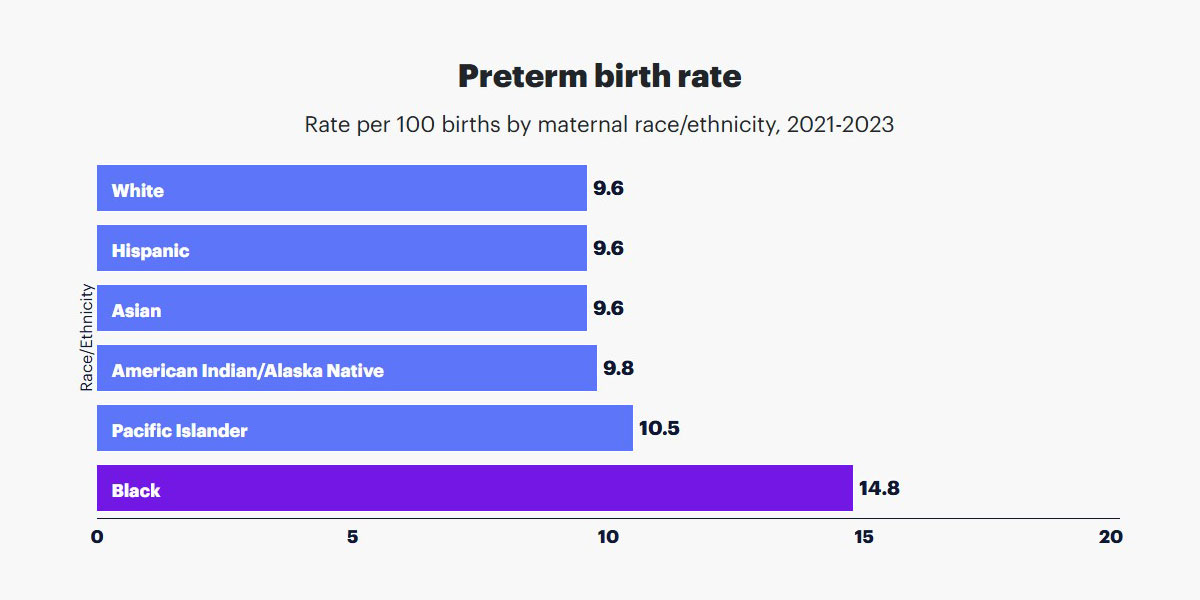
Source: March of Dimes
Preterm Birth Rate
29th
In 2022, Florida ranked 29th in the nation in infant mortality, with 5.8 deaths per 1,000 live births - equating to 1,342 deaths.
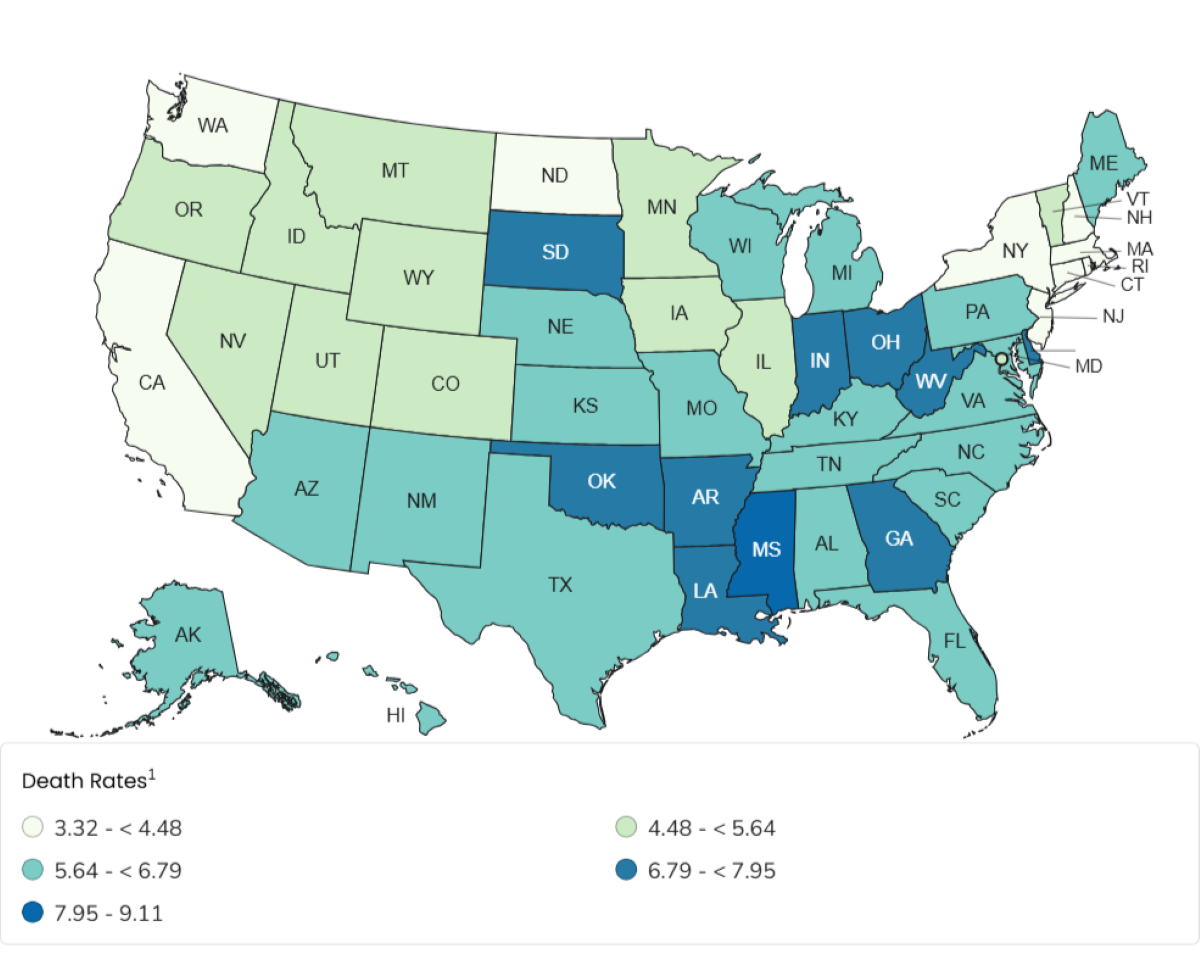
Source: U.S Centers for Disease Control and Prevention (September 2023)
Infant Mortality Ranking in the U.S.
24.1 out of 100,000
Between 2018 and 2022, 24.1 out of every 100,000 Florida mothers died from complications from childbirth, pregnancy, or within 6 weeks of pregnancy ending.
Sources: FL Health CHARTS and Maternal Vulnerability Index
Maternal Mortality
64.4%
Using the Kotelchuck Index, the national standard for prenatal care statistics, 64.4% of mothers in Florida received adequate prenatal care, up 2 percent from the year before but down from the recent high of 70.8% in 2017.
Source: FL Health CHARTS (county-level data and interactive dashboard available)
Women Who Received Adequate Prenatal Care
19.2%
19.2% of Florida mothers report that they have never breastfed their children, a decline from 2023.
Mothers Who Reported Never Breastfeeding
416
The Florida Breastfeeding Coalition has granted their "Breastfeeding Friendly Employer" award to 416 businesses, with three different tiers of award. Additionally, they designate 492 child care centers as breastfeeding friendly.
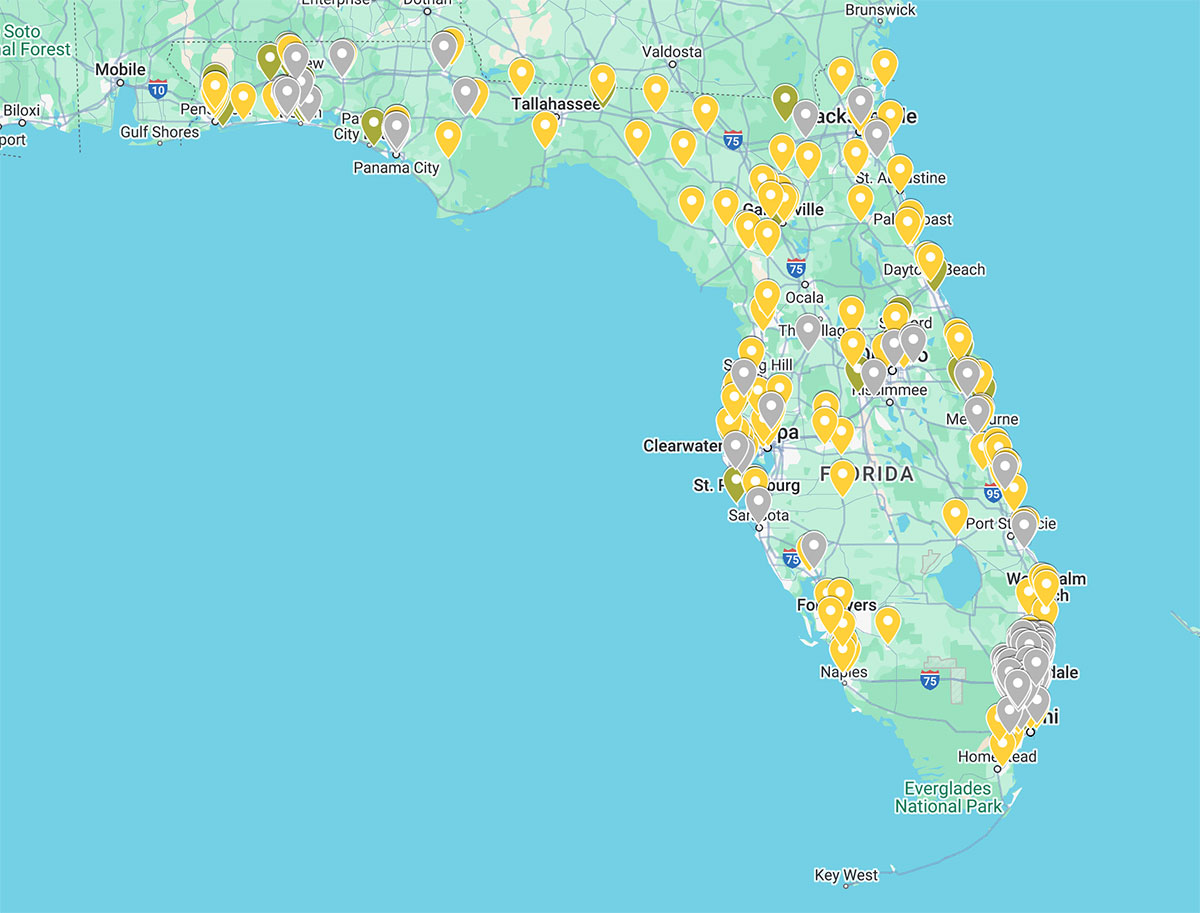
Source: Florida Breastfeeding Coalition, Inc. (February 2025)
Breastfeeding-Friendly Businesses in Florida
22
There are 22 baby-friendly hospitals in Florida as designated by Baby-Friendly USA.

Source: Baby-Friendly USA (June 2025)
Baby-Friendly Hospitals
14,720
In 2023, 14,720 Florida families received home visiting services through either the Child First, Early Head Start Home-Based Option, Family Check-Up, Healthy Families America, Home Instruction for parents of Preschool Youngsters, Nurse-Family Partnership, or Parents as Teachers model. 97 agencies provided these services locally throughout the state.
Families Receiving Home Visiting Services
Healthy Development
2,415,918
Total enrollment for Florida KidCare, the state's blanket health insurance program for children, was a little over 2.4 million at the end of 2023, a decrease over the prior three years. Medicaid was be far the largest insurance provider under that umbrella, accounting for 92% of enrollments. Medicaid is presented in a different graph from the rest of the programs due to its scale being so much larger. As you'll see below, as children disenroll from Medicaid over the years, more move into full-pay or other subsidized programs.
Florida KidCare Enrollment
29.8%
In 2023, only 29.8% of Florida 1 and 2 year-olds had preventive dental care, lower than the national average.
Source: State of Babies
Infants who received preventive dental care
66%
66% of Florida children under the age of 3 received no developmental screenings to catch disorders and delays, 44th in the nation (a slight improvement in rank from the prior year).
Children under 3 not receiving Developmental Screening
45.6%
Over the last ten years, the percentage of eligible infants and toddlers enrolled in and utilizing Early Steps early screening has steadily decreased, with a modest increase between 2021 and 2023.
Source: FL Health CHARTS
Eligible Families Served by Early Steps
24,913
Florida Diagnostic & Learning Resource System's (FDLRS) Child Find program helped evaluate 24,913 children for IDEA Part B services in the 2023-2024 school year. This is the next step in support for children with developmental delays or disabilities as they age out of the Early Steps program. (Note data for 2020-2021 is not readily available online.)
FDLRS Evaluations
43 of 67
There are 15 regional Help Me Grow partner organizations that administer services, referrals, and screenings across 43 of Florida's 67 counties.
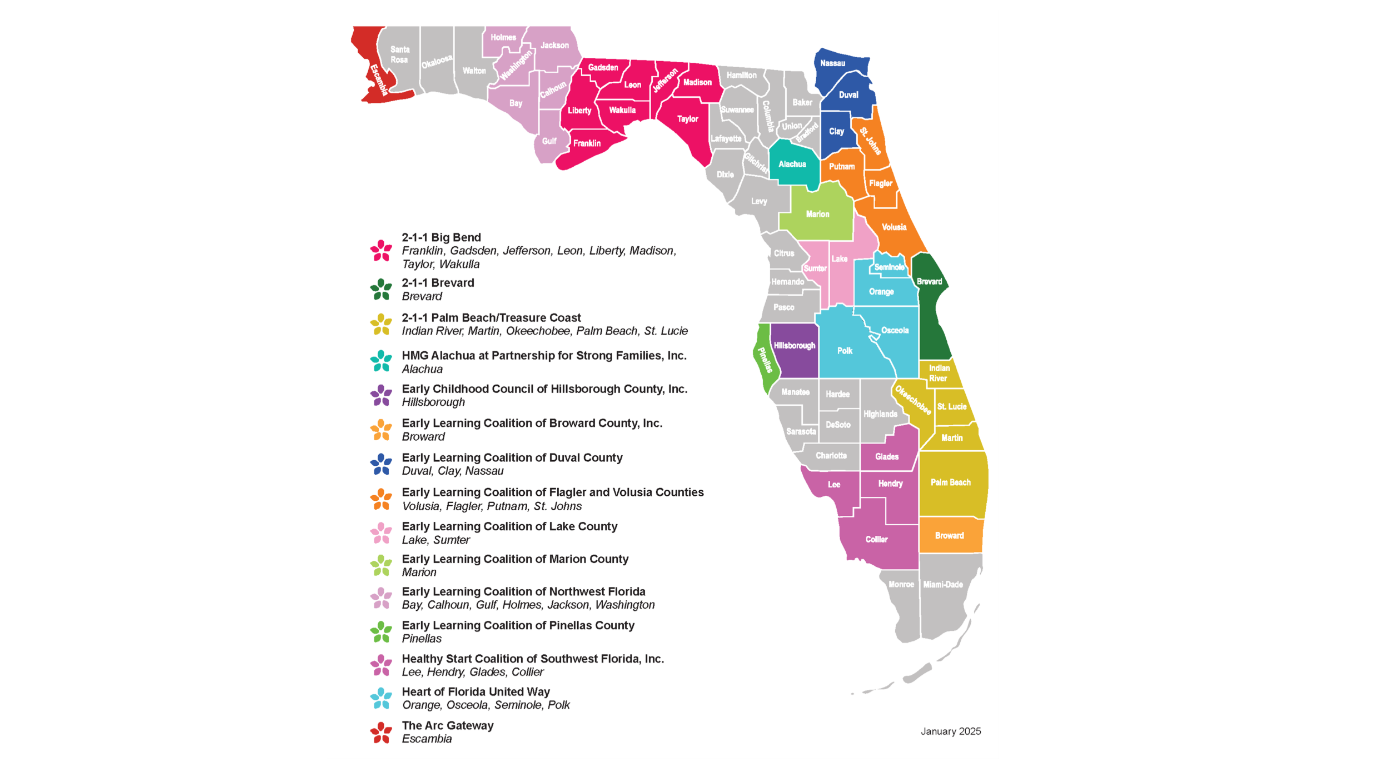
Source: Help Me Grow Florida (interactive map available on website)
Counties in the Help Me Grow Florida Network
5,136
5,361 individual children were referred to services through the Help Me Grow network in fiscal year 2023-2024, an increase over the last few years but below the high of 6,471 of 2018-2019. In addition, 9,221 screenings were completed, an increase of more than 2,000 over the prior year.
Sources: Help Me Grow Florida and Florida Department of Education
Children Served by Help Me Grow
427,219
427,219 mothers are currently served by the Supplemental Nutrition Program for Women, Infants and Children (WIC), representing 72.9% of the eligible population. This is an improvement over the prior nine years, but still a notable decrease from early 2010s, when more than 80% of eligible women were served.
Source: FL Health CHARTS (county-level data and interactive dashboard available)
Women Served by WIC
16
There are 16 children's hospitals in Florida, 4 of which are specialty-licensed hospitals for children, meaning they exist outside of a larger regional hospital or hospital system and exclusively treat children. The other 12 are part of systems like Jackson, Memorial, and AdventHealth.
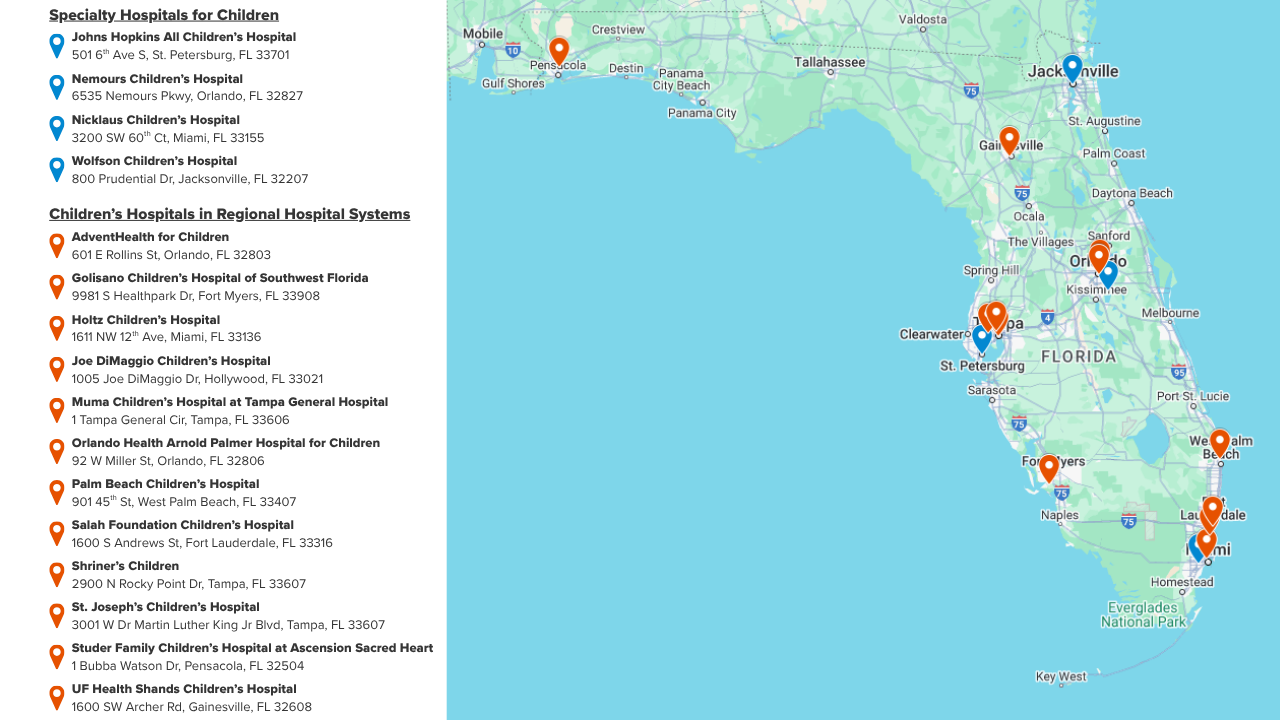
Sources: Florida Association of Children's Hospitals, Inc. and Florida Specialty Hospitals for Children
Children's Hospitals in Florida
Funding
$3,029
Florida VPK's Base Student Allocation (BSA) has incrementally increased in dollar amount since its inception in 2005, though it has actually decreased when factoring in inflation. The BSA in 2025 held steady at $3,029, the same as the year prior.
Sources: Florida Senate and Florida House of Representatives
VPK Base Student Allocation
$434 Million
Funding for Florida's VPK program decreased slightly in 2025, amounting to $434,199,644, and falling short of 2022's record-high allocation.
Source: Florida Senate
VPK Program Allocation
$91 Million
Florida's Early Steps program, which provides early screenings and services for developmental delays and disorders in young children, received $91,009,910 in funding in 2025, an increase of more than $2 million over the prior year.
Source: Florida Senate
Early Steps Program Allocation
$4.5 Million
Help Me Grow, Florida's early childhood resource referral network, maintained its funding at $4,500,000 in funding in 2025 - the same as the prior two years, but a marked improvement over the last decade.
Source: Florida Senate
Help Me Grow Network Allocation
$922 Million
Florida KidCare, which is made up of Florida Healthy Kids, MediKids, and Children's Medical Services, received $922,744,662 in funding in 2025, an increase of more than $140 million over the prior year, and a continuation of the increase in funding beginning in 2023.
Source: Florida Senate
Florida KidCare Allocation
$20 Million
Florida's T.E.A.C.H. Scholarship program received an increase of $3 million in funding in 2025.
Source: Florida Senate
T.E.A.C.H. Program Allocation
Additional Resources
If you want to dig deeper into the data, the tools below are particularly helpful, interactive resources:
- The Sunshine Portal: This integrated data system, created by the University of Florida’s Anita Zucker Center for Excellence in Early Childhood Studies, is a crucial source about access to and quality of state-funded School Readiness and VPK programs, as well as analyses of economic self-sufficiency for families with early learners.
- The Florida Scorecard: This Florida Chamber Foundation resource contains tiles across six categories (including talent & education and quality of life), with color coding to show when data is trending in a positive or negative direction. You’ll find even more in the Florida Gap Map, which contains interactive zip-code-level maps on opportunity metrics related to student success.
- FL Health CHARTS: This Florida Department of Health dashboard contains official annual statistics on a range of health-related metrics, from birth rates to prenatal care and eligible children served by a particular program. You can search for specific topics on the home page, and access county-level data and trends for most metrics that you search.
- KIDS COUNT Data Center: This tool from the Annie E. Casey Foundation contains data and statistics related to children, families, and their well-being–for all U.S. states and territories. You can create customized reports with the different demographic, economic, educational, and health metrics available on the site.